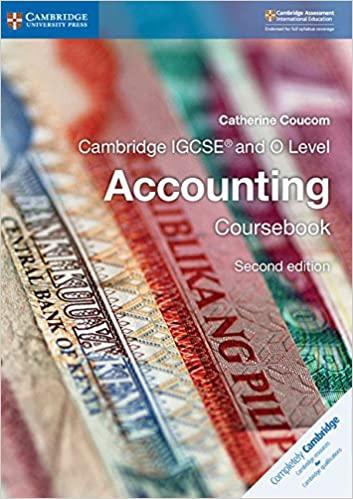Question
Saturn Ltd is considering investing in a new piece of equipment to improve its manufacturing processes. The machine will cost 115,000 and is expected to
Saturn Ltd is considering investing in a new piece of equipment to improve its manufacturing processes. The machine will cost 115,000 and is expected to be used for five years, after which it is expected to be sold for 25,000. It is estimated that the new machine will result in the following operating profits:
Year 1: 15,000
Year 2: 25,000
Year 3: 25,000
Year 4: 20,000
Year 5: 30,000
Calculate the accounting rate of return of the machine. Round off your answer to two decimals. Remember to show all your calculations.
Question 2
Imagine you are the manager of a business. After calculating the payback period of two different potential investment opportunities, you find the payback periods of both investments are shorter than the payback period required by the business. One investment opportunity's payback period is however shorter than the other.
2.1 Which one of the two investment opportunities should you pursue?
2.2 What is the disadvantage of using the payback period approach to investment appraisal? (That is, in what way might it lead to poor decision-making?)
Question 3
You are provided with the following information regarding two potential investment opportunities:
Investment X | Investment Y |
Initial cost: 1,200,000 | Initial cost: 1,100,000 |
Cash flow Year 1: 400,000 | Cash flow Year 1: 900,000 |
Cash flow Year 2: 500,000 | Cash flow Year 2: 400,000 |
Cash flow Year 3: 500,000 | Cash flow Year 3: 500,000 |
Cash flow Year 4: 600,000 | Cash flow Year 4: 600,000 |
Cash flow Year 5: 600,000 | Total cash flows: 1,300,000 |
Total cash flows: 1,400,000 |
The business can only invest in one of the opportunities, and the required rate of return is 8%.
3.1 Which one of the two opportunities appear more lucrative, only looking at the cash flows over the lifetime of the investments?
3.2 Now, evaluate the two investment opportunities, using the net present value technique. Make use of the following extract from a discount table in your calculations.
1% | 2% | 3% | 4% | 5% | 6% | 7% | 8% | 9% | 10% | |
1 | 0.990 | 0.980 | 0.971 | 0.962 | 0.952 | 0.943 | 0.935 | 0.926 | 0.917 | 0.909 |
2 | 0.980 | 0.961 | 0.943 | 0.925 | 0.907 | 0.890 | 0.873 | 0.857 | 0.842 | 0.826 |
3 | 0.971 | 0.942 | 0.915 | 0.889 | 0.864 | 0.840 | 0.816 | 0.794 | 0.772 | 0.751 |
4 | 0.961 | 0.924 | 0.888 | 0.855 | 0.823 | 0.792 | 0.763 | 0.735 | 0.708 | 0.683 |
5 | 0.951 | 0.906 | 0.863 | 0.822 | 0.784 | 0.747 | 0.713 | 0.681 | 0.650 | 0.621 |
Complete the following template to answer this question:
Investment X | Discount factor | Net present value |
| TOTAL: |
Investment Y | Discount factor | Net present value |
| TOTAL: |
3.3 Based on the calculations performed in 3.2, which one of the two investments should the business pursue? Justify your answer.
Question 4
Assume that the net present value for an investment is calculated as 14,000, at a rate of return of 8%. What does this imply about the internal rate of return?
Step by Step Solution
There are 3 Steps involved in it
Step: 1

Get Instant Access to Expert-Tailored Solutions
See step-by-step solutions with expert insights and AI powered tools for academic success
Step: 2

Step: 3

Ace Your Homework with AI
Get the answers you need in no time with our AI-driven, step-by-step assistance
Get Started


